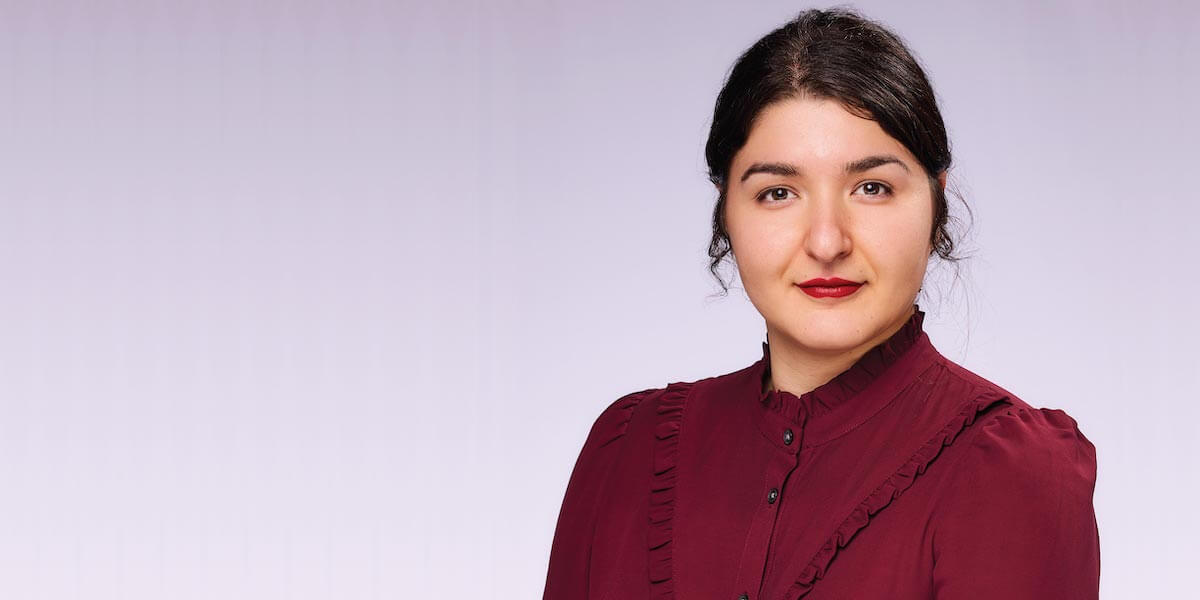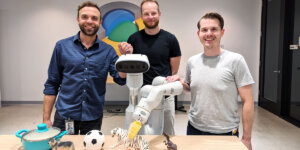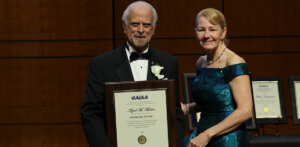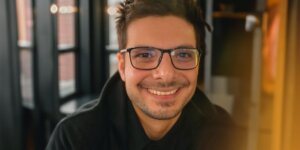
Assistant Professor of Biomedical Engineering Maral Mousavi has been awarded a $2.3 million NIH Director’s New Innovator Award to develop nano-scale sensors that will track how our nervous system communicates with our body’s cells. Image/Rafael L.
Neurotransmitters are the body’s chemical messengers, carrying vital signals from our nervous system to the cells around our body. Perhaps the most well-known neurotransmitters are serotonin and dopamine — linked to mood — and acetylcholine, which has a critical function in human learning and memory. When it comes to neurological disorders such as Alzheimer’s and dementia, measuring the transmission of acetylcholine will be key to understanding disease pathology and developing therapeutics to target these debilitating conditions.
However, understanding how cells communicate via neurotransmitters is one of science’s most complex challenges, often requiring highly specialized sensors that are complex to operate and not accessible to many scientists. It is a challenge that Assistant Professor of Biomedical Engineering Maral Mousavi aims to address thanks to a prestigious $2.3 million NIH Director’s New Innovator Award. The award will allow her to develop unique nano-scale sensors to understand these important chemical signals.
“We want to understand how cells communicate and what happens in the disease state when this communication goes wrong,” Mousavi said.
“We know that acetylcholine is involved in learning, and we know that it is altered in Alzheimer’s Disease and other neurodegenerative diseases. But there are a lot of questions in terms of what happens during this process,” Mousavi said.
To this end, Mousavi will be creating “biorthogonal” nanosensors, which are designed to be non-toxic and are fabricated from fluorous compounds — molecules with high fluorine content that do not interfere with biology.
“These compounds are extremely nonpolar to the point that they do not mix with oils nor with water,” Mousavi said. “In other words, these highly fluorinated compounds are hydrophobic and lipophobic, meaning they do not interact with water and fat. Our bodies are comprised of water and lipids (fats), thus making fluorous compounds biorthogonal.”
Mousavi said this would be the first time nanosensors responsive to neurotransmitters would be developed from these compounds. The big advantage and highlight of this new technology is the low toxicity of the sensors to cells while allowing high stability in-vivo and in-vitro.
“You could use them to monitor what happens in a cell culture. You could put them directly in the brain or inject them into different environments and then image with them,” Mousavi said. “In my research, we aim to create new tools that are simple to use and can be placed in the hands of many scientists.”
A two-way communication system to understand the nervous system
Not only will these new sensor tools offer an invaluable window into the chemical environment of cell communication, but they can also change that environment through chemical stimulation, offering therapeutic approaches to neurological and nervous system disorders, such as Alzheimer’s.
“It’s something that’s never been done before — for you to have that capability to sense and manipulate your environment at the same time and to create a dialogue with the system. You are not just hearing, but you can also speak back. You can stimulate by releasing a specific neurotransmitter,” Mousavi said.
Mousavi said she hoped the platform could eventually be harnessed to treat neurological disorders via local chemical stimulation.
“This project has a lot of components and many high-risk elements. It does not fit in the scope of traditional NIH grants. I am excited to have support from NIH Director’s New Innovator Award. They are looking for things outside the box— Ideas that are high-risk, but if they work it’s going to be a game-changer,” Mousavi said.
The NIH Director’s New Innovator Award supports exceptionally creative early career investigators who propose innovative, high-impact projects in the biomedical, behavioral, or social sciences within the NIH mission. The award was established in 2009 to support high-risk ideas that can potentially transform the state-of-the-art.
Mousavi joined the USC Viterbi Department of Biomedical Engineering in 2019, following her role as a postdoctoral fellow at Harvard University. She completed her Ph.D. studies at the University of Minnesota, and her B.S. studies at Sharif University of Technology.
She has been the recipient of numerous awards and honors, including the 3M Nontenured Faculty Award, the Research Award from Powell Foundation, the Zumberge Diversity and Inclusion Research Award, and the Grand Prize of the Maseeh Entrepreneurship Prize Competition (MEPC).
Mousavi’s electrochemical sensing work will also feature within a new $11.7 million NIH-supported center to develop open-source implantables for the nervous system.
Published on November 4th, 2022
Last updated on November 4th, 2022













